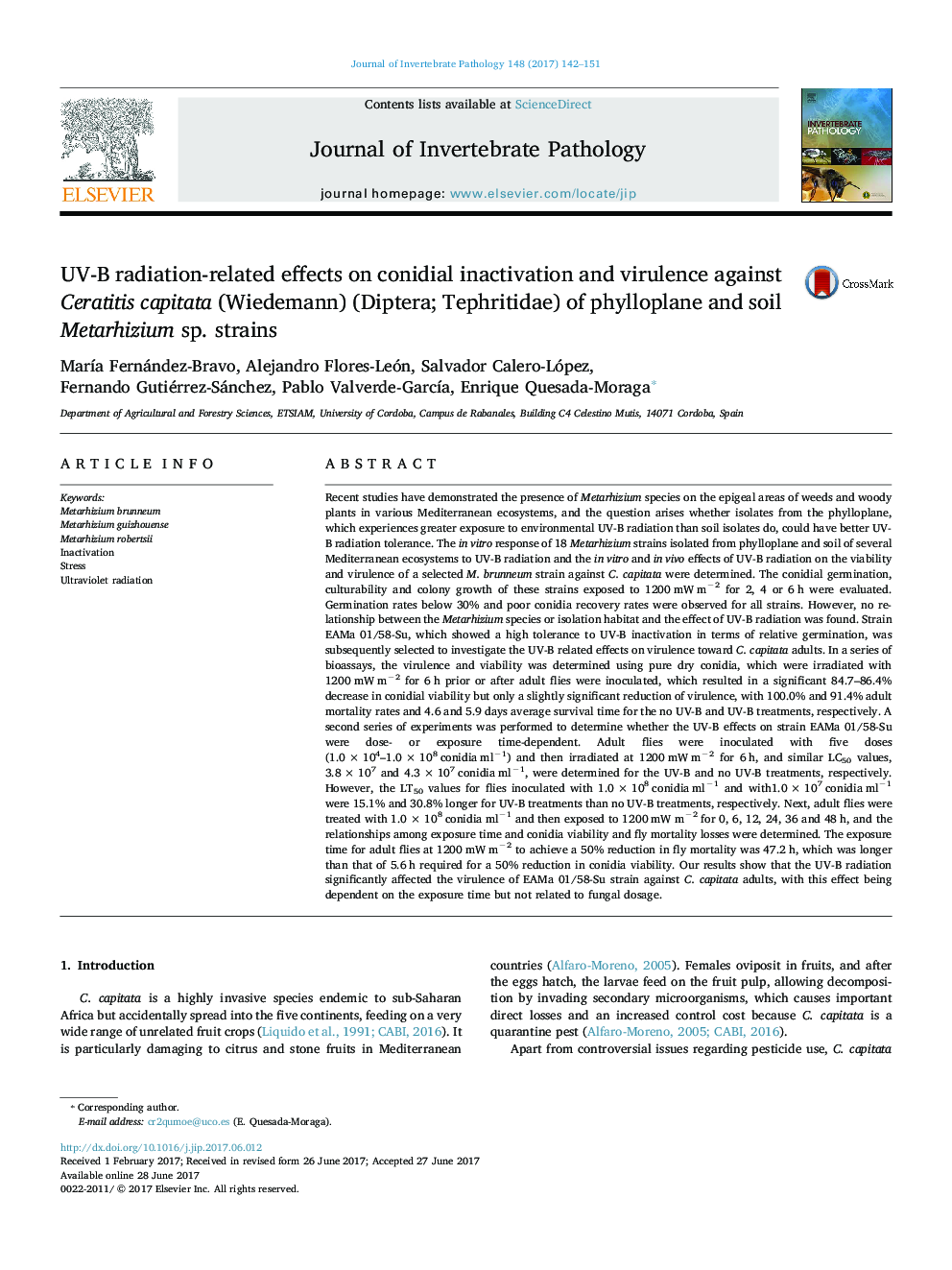| کد مقاله | کد نشریه | سال انتشار | مقاله انگلیسی | نسخه تمام متن |
|---|---|---|---|---|
| 5767033 | 1628204 | 2017 | 10 صفحه PDF | دانلود رایگان |

- Phylloplane isolates does not show better UV-B radiation tolerance those from the soil.
- The UV-B exposure time is the limiting factor in determining virulence loss.
- The exposure time needed for a 50% reduction in fly mortality was 47.2Â h.
- The exposure time needed for a 50% reduction in conidial viability was 5.6Â h.
- High UV-B exposure related conidial inactivation rates do not result in virulence loss.
Recent studies have demonstrated the presence of Metarhizium species on the epigeal areas of weeds and woody plants in various Mediterranean ecosystems, and the question arises whether isolates from the phylloplane, which experiences greater exposure to environmental UV-B radiation than soil isolates do, could have better UV-B radiation tolerance. The in vitro response of 18 Metarhizium strains isolated from phylloplane and soil of several Mediterranean ecosystems to UV-B radiation and the in vitro and in vivo effects of UV-B radiation on the viability and virulence of a selected M. brunneum strain against C. capitata were determined. The conidial germination, culturability and colony growth of these strains exposed to 1200 mW mâ2 for 2, 4 or 6 h were evaluated. Germination rates below 30% and poor conidia recovery rates were observed for all strains. However, no relationship between the Metarhizium species or isolation habitat and the effect of UV-B radiation was found. Strain EAMa 01/58-Su, which showed a high tolerance to UV-B inactivation in terms of relative germination, was subsequently selected to investigate the UV-B related effects on virulence toward C. capitata adults. In a series of bioassays, the virulence and viability was determined using pure dry conidia, which were irradiated with 1200 mW mâ2 for 6 h prior or after adult flies were inoculated, which resulted in a significant 84.7-86.4% decrease in conidial viability but only a slightly significant reduction of virulence, with 100.0% and 91.4% adult mortality rates and 4.6 and 5.9 days average survival time for the no UV-B and UV-B treatments, respectively. A second series of experiments was performed to determine whether the UV-B effects on strain EAMa 01/58-Su were dose- or exposure time-dependent. Adult flies were inoculated with five doses (1.0 Ã 104-1.0 Ã 108 conidia mlâ1) and then irradiated at 1200 mW mâ2 for 6 h, and similar LC50 values, 3.8 Ã 107 and 4.3 Ã 107 conidia mlâ1, were determined for the UV-B and no UV-B treatments, respectively. However, the LT50 values for flies inoculated with 1.0 Ã 108 conidia mlâ1 and with1.0 Ã 107 conidia mlâ1 were 15.1% and 30.8% longer for UV-B treatments than no UV-B treatments, respectively. Next, adult flies were treated with 1.0 Ã 108 conidia mlâ1 and then exposed to 1200 mW mâ2 for 0, 6, 12, 24, 36 and 48 h, and the relationships among exposure time and conidia viability and fly mortality losses were determined. The exposure time for adult flies at 1200 mW mâ2 to achieve a 50% reduction in fly mortality was 47.2 h, which was longer than that of 5.6 h required for a 50% reduction in conidia viability. Our results show that the UV-B radiation significantly affected the virulence of EAMa 01/58-Su strain against C. capitata adults, with this effect being dependent on the exposure time but not related to fungal dosage.
229
Journal: Journal of Invertebrate Pathology - Volume 148, September 2017, Pages 142-151